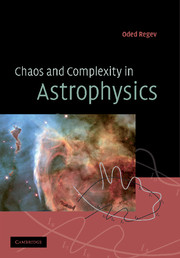Book contents
- Frontmatter
- Contents
- Preface
- Acknowledgements
- Part I Dynamical systems – general
- Part II Astrophysical applications
- 8 Introduction to Part II
- 9 Planetary, stellar and galactic dynamics
- 10 Irregularly variable astronomical point sources
- 11 Complex spatial patterns in astrophysics
- 12 Topics in astrophysical fluid dynamics
- References
- Index
8 - Introduction to Part II
Published online by Cambridge University Press: 14 January 2010
- Frontmatter
- Contents
- Preface
- Acknowledgements
- Part I Dynamical systems – general
- Part II Astrophysical applications
- 8 Introduction to Part II
- 9 Planetary, stellar and galactic dynamics
- 10 Irregularly variable astronomical point sources
- 11 Complex spatial patterns in astrophysics
- 12 Topics in astrophysical fluid dynamics
- References
- Index
Summary
There is nothing stable in the world; uproar's your only music.
John Keats, Letter to G. and T. Keats.The first part of this book contained a rather extensive survey of the mathematical background needed for the study of various types of dynamical systems. The following, second part will be devoted to applications of some of these (often quite abstract) mathematical ideas and techniques to a selection of dynamical systems derived from astrophysical problems. The connection between mathematics and astronomy is a well known fact in the history of science. Sir James Jeans, the great British astronomer and mathematician, illustrated this by writing in 1930 that ‘… the Great Architect of the Universe now begins to appear as a pure mathematician.’
The mathematical theory of non-integrable Hamiltonian systems indeed followed directly from the gravitational n-body problem – a model of the most ancient and basic astronomical dynamical system. Dissipative chaos was first explicitly demonstrated in numerical calculations of simplistic models of thermal convection, a fluid-dynamical phenomenon having an obvious relevance to astrophysics. It is thus only natural to look for additional applications of dynamical system theory in astrophysics. Astrophysics is a relatively young science and many of its achievements have been made possible by modern advances in technology. The space programmes of the competing superpowers gave rise to enormous progress in electronics, enabling the development of modern observational instruments and powerful digital computers. Astronomers are today able to collect a wealth of data in virtually all the bands of the electromagnetic spectrum and store and analyse them effectively.
Information
- Type
- Chapter
- Information
- Chaos and Complexity in Astrophysics , pp. 257 - 259Publisher: Cambridge University PressPrint publication year: 2006
